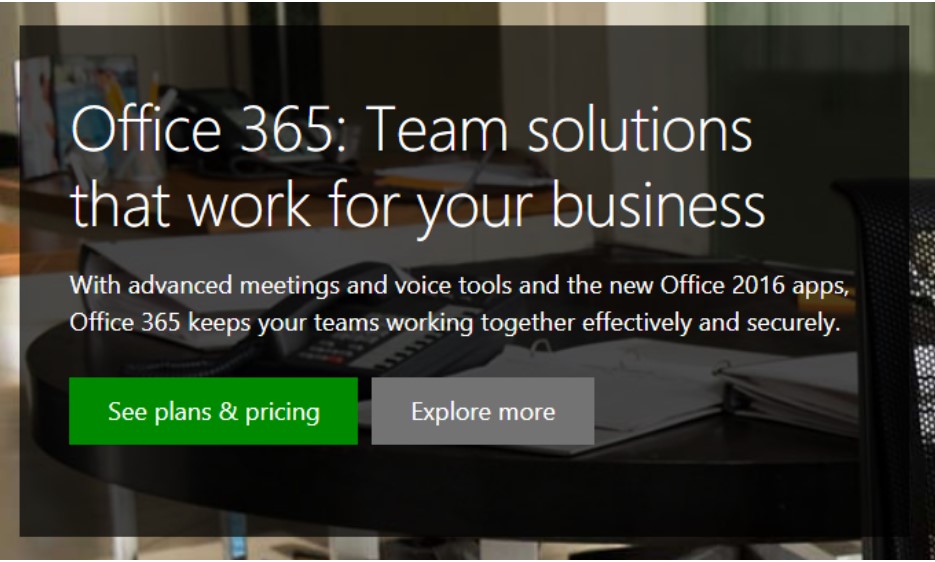Migrating from On Premise to Microsoft Office 365

Businesses moving to the public cloud today look for powerful solutions that allow them to be more mobile, agile, and technology progressive than keeping infrastructure only in on-premise datacenters. There are certainly many options available to organizations today. Organizations comparing different public cloud vendors have to consider and weigh out the services offered as well as the cost for those services as one cloud provider may align more closely to the business needs and objectives than another cloud provider.
Out of the big three providers including Amazon, Microsoft, and Google, many today are making use of Microsoft’s Office 365 offering as it provides tremendous functionality and the well-known Microsoft Office suite of products that many businesses are already utilizing on-premise. This familiarity with Microsoft’s products can certainly sway organizations to make the choice to house their infrastructure and services in the Microsoft public cloud.
In this two-part post, we will consider the both the infrastructure and services that are available to organizations who are thinking of migrating to the Microsoft Office 365 public cloud as well as the challenges businesses may encounter when migrating from on-premise environments to Microsoft’s Office 365. First, let’s take a look at Microsoft’s Office 365 public cloud in more detail and the reasons many organizations decide to go with Microsoft’s Office365 solution when migrating to public cloud.
Microsoft Office 365 – Powerful and Familiar Business Services
Microsoft Office 365 public cloud offering provides a powerful suite of services for organizations looking to move services and infrastructure to the public cloud. Microsoft’s major advantage when compared to other vendors in the public cloud space is the familiarly with Microsoft Office software applications. There is arguably no stronger vendor in the SMB and enterprise space for office productivity software than Microsoft.
The traditional software suite containing Microsoft Word, Excel, PowerPoint, and Outlook is known and loved by many business professionals. Since Microsoft’s Office 365 provides access to the latest and greatest versions of these business productivity applications, it is not a hard sell to thinking about migrating Office productivity applications to the Microsoft public cloud. This also makes the learning curve much more streamlined for end users migrating from on-premise to Office 365 since the applications are essentially the same.

Office 365 provides powerful solutions for the Enterprise (image courtesy of Microsoft)
This familiarly with Microsoft Office is also its “Achilles heel” as many mistakenly think that Office 365 is simply Microsoft Office tools running in the cloud. However, Microsoft Office 365 is much more than the Microsoft Office products running in the public cloud. Microsoft Office 365 is a powerful collection of business productivity tools and services including Microsoft Office products that allow businesses to effectively have the entire portfolio of products and services needed to carry out businesses operations effectively and efficiently. These tools include:
- Sharepoint Online
- OneDrive for Business
- Skype for Business
- Yammer
- Public Switched Telephony Network (PSTN) or Cloud PBX
- Advanced analytics with Power BI and Microsoft MyAnalytics
- Advanced security, with Advanced Threat Protection and Customer Lockbox
Microsoft Office 365 Solutions break down into the following categories:
- Teamwork
- Mobile Productivity
- Analytics & Intelligence
- Security & Compliance
- Business Growth Tools
Microsoft Office 365 Teamwork
Microsoft’s Office 365 Teamwork component of Office 365 contains services and applications that allow business teams to communicate and collaborate effectively. These include the following offerings:
- Office 365 Applications
- Business Email and Calendaring
- File Storage and Sharing
- Online Meetings and Business Voice
- Microsoft Teams
Office 365 Applications
The first listing of Microsoft’s portfolio of services found under the Teamwork designation is Office 365 Applications. These are the familiar desktop applications that most are already familiar with on-premise – Word, Excel, and PowerPoint just to name a few. The really powerful part of the Microsoft Office 365 ecosystem is that Microsoft has connected all the various platforms that you may edit and work with files such as the desktop version, mobile, or web versions. As long as files are stored in cloud storage, these can be accessed and easily edited by Office applications running on any device or platform.
Additional benefits with Office Applications are found in the Office 365 architecture behind the scenes. Office 365 keeps your Office applications up to data and in sync across platforms, so end users are able to focus time on what matters most – collaborating with team members and updating/editing files.
End users also get the increased productivity that is enabled due to the built-in intelligence found in the Office 365 Office Applications. Office 365 Applications contain intelligent services such as Resume Assistant, Designer, and Insight Services.
Business Email and Calendaring
Email and scheduling are core business services that most organizations rely on very heavily for effective communication. Microsoft’s Office 365 Business Email and Calendaring empowers teams with group inbox, calendar, and conversations. Teams can share files as cloud saved attachments and use the @mentions tags for important conversations.
The products included with Microsoft’s business email and calendaring offering include Microsoft Outlook and Exchange Server. All of your emails, calendars, and contacts are synced across devices in real time. Additionally, administrators have control to perform remote wipes of devices that are lost or stolen to keep information secure.
File Storage and Sharing
An additional core requirement for teams collaborating and connecting is the ability to share content in file storage and easily share this information. Powerful Microsoft Office mobile apps allow easily connecting to and sharing data while on the go. The File and Storage Sharing functionality within Microsoft Office 365 includes SharePoint and also OneDrive.
OneDrive allows access to your files and content from anywhere and is already installed in today’s Windows operating systems so it is ready to start saving files and syncing to the Microsoft Office 365 public cloud. SharePoint extends the sharing and collaboration features and functionality of OneDrive so teams can build team sites or intranet sites across the organization. Files saved to OneDrive or SharePoint easily allow co-authoring so collaboration is easily achieved.
Online Meetings and Business Voice
Microsoft’s Online Meetings and Business Voice allows organizations to call, meet and engage remotely and in real time. This includes HD video, instant messaging, screen sharing, as well as audio. Additionally, teams can broadcast meetings to up to 10,000 people with customized URLs, Q&A’s and more. The online meetings solution includes Skype for Business and Microsoft Teams service. Microsoft makes this available on the go with mobile access as well with mobile meeting apps for Android, IOS, and Windows Phone
The Business Voice aspect of the solution allows organizations to migrate to a truly hosted cloud PBX voice solution. This allows making local, long distance, and international calls and also empowers IT to be able to rapidly provision numbers. The business voice solutions can also be tailored to the needs of the organization with deployment options on-premises, hybrid, or completely in the cloud.
Microsoft Teams
Microsoft Teams provides a hub to bring together team’s chats, meetings, files, and apps to easily collaborate on projects. All of the functionality is easily brought together for team members across platforms, services, software, and communication apps in a seamless integration that allows teams to stay cohesive.
Microsoft Office 365 Mobile Productivity
In today’s world of business, having the flexibility to interact with, manage, and edit content, communicate, and collaborate with colleagues via mobile device is arguably a requirement. Microsoft Office 365 has been geared towards a seamless user experience across devices, including mobile. It allows the following features:
- Access Anywhere
- File Storage and Sharing
- Email and Calendaring
- Mobile Data Protection
Access Anywhere
This is a recurring theme with the solution – access anywhere. Microsoft has engineered Office 365 to allow you to access any Office 365 resources anywhere and from any device, no matter what the platform.
File and Storage Sharing
File and Storage Sharing on mobile devices allows teams to access files and storage on mobile devices as well as desktops. Accessing the same data everywhere with OneDrive and Sharepoint makes Microsoft Office 365 storage extremely powerful.
Email and Calendaring
The email and calendaring piece as we have already covered provides the power of Exchange and Outlook both on desktop and mobile devices to synchronize email, calendars, and contacts across devices in real time.
Mobile Data Protection
With today’s security threats, organizations must be conscious about security. Mobile devices are perhaps the most dangerous devices in an organization. Office 365 mobile data protection helps to secure businesses from threats across phones as well as tablets.
Microsoft Office 365 Analytics and Intelligence
Businesses today are empowered to thrive when they have access to actionable insights across the organization. Data analysis puts real intelligence into both business and productivity challenges. Office 365 provides powerful analytics and intelligence tools:
- Data Analysis and Spreadsheets
- Productivity Analysis
- Intelligent Office Applications
- Business Intelligence
- Search and Discovery
Data Analysis and Spreadsheets
Office 365 provides intelligent data analysis. Organizations are able to create live dashboards connected to multiple data sources. Interactive reports are easily created containing charts, data visualizations and other rich insights.
Productivity Analysis
The Productivity analytics provides by Office 365 helps teams to be more productive with both personal analytics and workplace analytics that provide both communication and collaboration trends.
Intelligent Office Applications
Office 365 applications have artificial intelligence built in that allows Office 365 applications to learn the needs of team members and provides information that is most needed to those users before they even ask for it. This drastically reduces the amount of time needed to complete tasks.
Business Intelligence
Office 365 applications allow turning the enormous amount of data that organizations have flowing, into meaningful information that can lead to a tremendous competitive advantage. This includes being able to feed live data into dashboards, interactive reports, and data visualizations.
Search and Discovery
Storing information in any system is only useful if you can find it. Office 365 Search and Discovery powered by the Delve application allows finding content in sites, files, and contacts with full-text queries across the entire Office 365 organization, including but not limited to OneDrive, SharePoint, and Yammer. Being able to search for and find needed information allows gaining insights and perspectives that help to make more intelligent business decisions.
Microsoft Office 365 Security and Compliance
In today’s security-conscious world with ever-increasing compliance regulations such as GDPR, organizations must give their full attention to security and compliance. Office 365 offers the following solutions to bolster security and compliance initiatives.
- Data Protection
- Compliance Solutions
- Threat Protection
- Office 365 Trust Center
Read more about the security aspects of Microsoft’s Office 365 MDM.
Data Protection
Microsoft Office 365 Data Protection allows organizations to configure rights management so that documents and emails are only viewed by authorized users based on permissions.
Compliance Solutions
Compliance is extremely important for organizations today. Just recently, GDPR compliance went into the effect. Along with PCI-DSS, GDPR brings new challenges to organizations and their data. Office 365 offers compliance solutions such as Customer Lockbox, Advanced eDiscovery, and Advanced Data Governance. Both the eDiscovery and Data Governance solutions leverage Microsoft’s machine learning algorithms to intelligently manage data. Customer Lockbox lets you control access to your data during service operations.
Additionally, as your data grows, Office 365 allows organizations to implement comprehensive advanced data governance and implement encryption and access control capabilities such as Customer Key for Office 365 and Office 365 Customer Lockbox. Customer Key allows you to control your own encryption keys. Office 365 Lockbox defines how Office 365 support engineers can access your data.
Threat Protection
Mitigating threats is key to helping secure organization data. With Office 365 Threat protection, organizations are able to leverage the power of Exchange Server which blocks 100% of known malware and reduces spam. Office 365 threat-protection helps defend against risky attachments, malicious links and malware. Threat intelligence helps to give visibility to malicious behavior and actionable insights with global attack patterns.
Office 365 Trust Center
Office 365 Trust Center is Microsoft’s commitment to transparency and customer’s trust in the security and ownership of their data. Trust Center is where Microsoft shares information about security, privacy, and compliance with customers. It contains four key areas – Built-in security, privacy by design, continuous compliance, and transparent operations.
Microsoft Office 365 Business Growth
Office 365 contains many tools that help organizations build and grow their business. These include customer relationship management, invoicing software, email marketing, automatic mileage tracking and business management dashboard. All of these tools have been designed in a simple, easy-to-use to way that helps businesses concentrate on the important business matters at hand rather than on how to use the tools themselves.
Concluding Thoughts
As we have covered in this post, Microsoft’s Office 365 public cloud solution is powerful. It provides all of the familiar applications that customers have been using in enterprise environments for years. This familiarity alone with Microsoft products helps to sway many businesses toward Microsoft’s solution for public cloud services and applications. Additionally, businesses are able to install Office applications locally when they buy into the solution.
Aside from the traditional office applications, there are many business productivity and collaboration tools and services that businesses can take advantage of that can springboard organizations into a much more modern approach to team communication and collaboration. Microsoft also has included really good security and tools by default that help organizations to meet at least the basic security and compliance needs. In the next post in the Cloud Migration Guide Migrating from On Premise to Microsoft Office 365, we will take a look at the challenges that organizations face in migrating from on-prem to the Microsoft Office 365 public cloud.
Was this helpful?
How Can You Maximize SaaS Security Benefits?
Let's get started with a live demo
Latest blog posts
Microsoft 365 Security Best Practices and Recommendations 2024
February 9, 2024Micorosft 365 is a business-critical cloud environment that contains terabytes of sensitive information. Protecting this... Read more
What data can be backed up from Microsoft 365?
January 5, 2024Microsoft 365 services contain business-critical data. However, none of the services has an in-built backup... Read more
Why do you need C2C backups for your online business?
January 1, 2024The amount of business-critical data stored in the cloud is increasing exponentially. So are the... Read more


